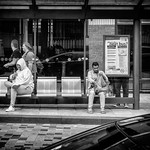- Preston City Council local elections 2024 candidates list set out
- Blog Preston reaches crowdfunding goal for expanded arts and culture coverage
- Harris Institute owners move to squash ‘for sale’ rumours
- “Unacceptable” and “must do better” as Preston records highest rough sleeper count since records began
- Preston Animate cinema reaches highest point in construction
Preston Past: Fishergate,100 years of change (Part 3)
Posted on - 3rd May, 2012 - 9:15am | Author - Paul D. Swarbrick | Posted in - History, Nostalgia, Photos
Looking down on the shop frontages of the south side of Fishergate 1950
In this weeks Preston Past we take a look at the south side of Fishergate from where it meets with Church Street and continues in a westerly direction.
AdvertisementAt the junction of Church Street and Fishergate on the south side there is a narrow passageway, which is the site of one of the many ‘Burgess plots’ (see footnote) that there is in this area of Preston.
This passageway is known as Main Sprit Weind which led to a well at the bottom of the hill. It has also been known at various times as Minspitt Lane, Minspitt weend and Pettycoat Alley. The latter being so called from the carrying of the daily milk, butter and water from the well by young pettycoated ladies along the narrow lane up to the town centre.
One of the residents of Main Sprit Weind was Roger Sudell, a Preston draper, who died in 1704 leaving a stable with a hay loft over it to be converted into a schoolhouse for the education of “children of the poorer sort“. Trustees ensured that this wish was fulfilled.
Following the demolition of the school in 1830 a new on was built on the site and was known as the Bluecoat School.
One of the inns existing in Main Sprit Weind in the early 1800’s was one known as the Sun of which the publican was one of Preston’s three policemen at that time. The two images immediately below show Main Sprit Weind in 1978 on the left and again in 2011 on the right as it is today.

Main Sprit Weind in 1978~~~~~~~~~~~~~~~~~~~~~~~~~~Main Sprit Weind in 2011
At one time, sandwiched between Main Sprit Weind and Glovers Court was the County Bank, a public house known as ‘Old Legs of Man’ and Booth’s store and cafe which are shown in the images immediately below. Eventually the County Bank took over the premises of the public house and extended up to the Booth’s store.
For many years the Booth’s store was the favourite place to shop for exotic foods, tea and coffee. Indeed, I can even recall my mother buying chocolate covered ants there in the late 1950’s. Although why anyone would want to is a puzzle to me. The cafe on the upper floor at Booth’s was a place to be seen and to discover all the current ‘goings-on’ in Preston, especially from the 1930’s to the mid 1900’s.
The Old Legs of Man public house was locally known as ‘The Legs’ and in it’s heyday was a very well known and often visited place by the adult population of Preston.

The Old Legs Of Man Public House ~~~~~~~~~~~~~~~~~~~~~~~~~~~Booth’s Store & Cafe

Front & rear views of Glover’s Court prior to the widening of the road in 1913
Branching off Fishergate and downhill alongside the Booth’s store, is a road known as Glover’s Court. Most Prestonians will know this place to have the ‘Booth’s Clock Bridge’ spanning overhead from one side of the road to the other.

G. Sharples Telephonic Exchange, 7 Fishergate, Preston est. 1880
However, up to 1913 Glover’s Court was not an open road at the Fishergate junction. Instead it was just a narrow passageway with an underpass leading from Fishergate to the court itself. The two images immediately above show views of how Glover’s Court appeared up to 1913. The left hand image shows Glover’s Court underpass entrance as viewed from Fisherage in 1910. Glover’s Court can be seen through the small underpass with Crompton’s Parmacist on the right of the underpass. The right hand image shows a view from being in Glover’s Court and looking out through the underpass to Fishergate.
Crompton’s at number 7 Fishergate was once the premises of G. Sharples, Telephone and electric light engineer and was used as a small telephonic exchange which was established in 1880.
The adjacent image, to the left, is an artists drawing of what the frontage of how that part of Fishergate appeared in the late 1800’s. The mass of telephone cables emanating from the roof of the building must have been a sight to behold, especially in those early days of telephone communication.
Footnote: A Burgess was a trader who, by various means, could freely trade within the Preston boundary and he was made a member of the Preston Guild Merchant which was granted by Royal Charter. Burgesses were allocated a Burgage, which was a narrow plot of land where he could keep livestock or grow produce for trade. The Burgess would have to construct a building on the Burgage in a given time in order to fulfill the obligations of their given title.
In the next article: Part 4 of ‘Fishergate,100 years of change’ and Part 2 here
This is a weekly series showcasing photos each week from the brilliant Preston Digital Archive which is an online archive of images of Preston’s past











 Advertisement
Advertisement